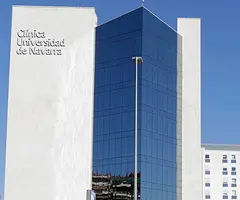Meningiomas
"It is recommended that treatment decisions be made within multidisciplinary units, where each specialist can contribute their experience for the benefit of the patient".
DR. BARTOLOMÉ BEJARANO
SPECIALIST. CENTRAL NERVOUS SYSTEM TUMORS AREA

Meningioma is the most common benign cranial tumor. It comes from cells in the coverings of the brain.
The meningioma does not grow inside the brain but it compresses it, normally pushing the brain parenchyma. Depending on where it is born, it can be more or less difficult to treat.
They are somewhat more frequent in women than in men and their incidence increases throughout life.
In addition to the risks inherent to each tumor due to its size and location, meningiomas are characterized by a high risk of deep vein thrombosis and pulmonary thromboembolism.

A PERSONALIZED MEDICINE
Second Opinion,
peace of mind
Request a second opinion from our professionals with great experience in the diagnosis and treatment of oncological diseases
In 3 days, without leaving home.
Symptoms of meningioma
The symptoms of meningioma vary depending on the site of origin, and they are slow-growing tumours, which is why they mainly give symptoms of slow compression of brain tissue. They are a type of tumour that grows over many years, so symptoms may appear slowly.
Some of the most common symptoms of meningioma are:
- Progressive headaches
- Epileptic seizures
- Almost any type of neurological disorders
Do you have any of these symptoms?
If you suspect that you have any of the above symptoms,
you should consult a medical specialist for a diagnosis.
Causes of meningioma
Genetic abnormalities have been described as a possible cause, although most occur in patients with no family history. Multiple meningiomas are common in patients with neurofibromatosis type 2.
Approximately two thirds of meningiomas express progesterone receptors, rarely oestrogen receptors. Accelerated growth during pregnancy and increased incidence in women who have received hormone replacement therapy after menopause have been reported.
Prognosis of meningioma
After complete excisions, the vast majority of tumours do not grow back, if any residual tumour remains. The likelihood of it growing back and causing problems increases over the years.
It is difficult to predict the evolution of an individual case, as there is a great deal of variability in the behaviour of tumours that look the same when analysed.
How is meningioma diagnosed?
After clinical suspicion of meningioma, imaging tests such as magnetic resonance imaging easily locate the lesion and often allow the correct diagnosis to be suspected.
Most meningiomas are benign, grade 1, although there may be grade 2 or 3 variants, which have a worse prognosis.
Types of meningiomas
Common symptoms of laryngeal cancer
- Dysphonia
- Pain on swallowing (odynophagia)
- pain radiating to the ear (reflex otalgia)
- Breathing difficulty
Symptoms if the tumour is in the glottis
The glottis houses the vocal cords, so any alteration in this area causes changes in the voice, known as dysphonia. This is the main sign of cancer located in the vocal cords.
Síntomas si el tumor está en la supraglotis
Los tumores en la supraglotis pueden no causar síntomas en estadios iniciales. A medida que crecen, suelen aparecer dolor al tragar (odinofagia), dolor irradiado al oído (otalgia refleja) o disfonía, si el tumor afecta a las cuerdas vocales.
Síntomas si el tumor está en la subglotis
Los tumores subglóticos pueden manifestarse como disfonía por afectación secundaria de las cuerdas vocales o por dificultad respiratoria debido a la obstrucción de la luz laringotraqueal.
Treatment of meningioma
The initial treatment for meningiomas is surgical removal. Recurrences are possible despite removal, but are very rare when the entire tumour and its base have been removed, and more frequent if some areas cannot be removed.
As an alternative to surgery, ionising radiation can be considered, either as a single dose (radiosurgery), as conventional fractionated radiotherapy, or as fractionated stereotactic radiotherapy. In general, the radiation treatment option has a lower immediate risk than surgery, and is a good option to stop tumour growth. The problem is that not all tumours are stopped and as the years go by, they may start to grow again.
Apart from the indication of radiosurgery as an alternative to surgery, there is the option of using it as a combined treatment. In cases of large tumours with areas whose removal poses an additional risk of morbidity, such as skull base implantation areas or cavernous sinus invasions.
Where do we treat it?
IN NAVARRA AND MADRID
Central Nervous System Tumors Area
of the Cancer Center Clínica Universidad de Navarra
In the Central Nervous System Tumors Area we offer maximum safety and efficiency in brain tumor surgery, being the first hospital with a high field magnetic resonance within the operating room.
We have a highly specialized team in the surgery of brain tumors, with more than 15 years of experience.
The individualized treatment of each case by an interdisciplinary team allows us to offer the best alternative to each patient.

Why at the Clinica?
- Integral evaluation of the patient.
- Cutting edge technology.
- Expert professionals who are a national reference.



























